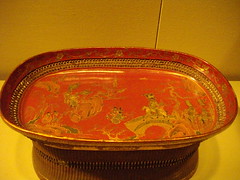Bunraku
Bunraku is one form of puppet theater. It has flourished since the seventeenth century and now stands with noh and kabuki as one of the three great classical forms of theater in Japan.

Bunraku puppets consist of a head, trunk, feet, and costume, and range in size from about a meter to a meter and a half.
On the stage, each puppet is manipulated by three puppeteers, These puppeteers wear black robes with a flap that covers the face. One puppeteer manipulates the puppet’s head and right hand, one the left hand, and one the feet. In the case of female dolls, which have no feet, the third man skillfully manipulates the skirts of the doll to give the impression of walking and other leg movements. The puppets perform the actions as the story is related in a special chant, called joruri, to the accompaniment of
Shamisen music. Because of this, bunraku is also called ningyojoruri (puppet ballad-drama).
There are only about forty kinds of puppet-heads, so each is used for a number of different roles. There are puppets with eyes and mouth that can be opened and shut, with eyebrows that move up and down, and fingers that move. Emotions are expressed be subtle movements.
【日本語訳】
文楽(人形浄瑠璃)
「文楽」は一種の人形劇である。能、歌舞伎と並んで日本三大古典演劇の一つで17世紀から盛んになった。
文楽で使う人形は首・手・足・衣装からなっていて1メートルから1.5メートルの大きさである。
舞台の上で、人形を人形遣いが1体につき3人で動かす。人形遣いは黒い衣で顔を隠しており、それぞれ首と右手・左手・足の動きを分担している。女の人形には足がなく、人形の衣装のすそさばきで巧みに表現する。人形は、三味線の伴奏と独特の節まわしで語る浄瑠璃語りにあわせて様々の仕草をする。このため、文楽のことを人形浄瑠璃とも言う。
人形の首は約40種類しかなく、一つの首をいろいろの役に使う。目や口が開閉するもの、眉が上下する物、指の動くものもある。感情の動きなども人形の微妙な動作で表現される。



